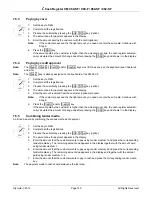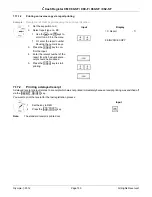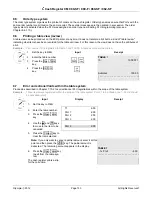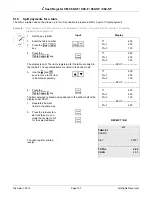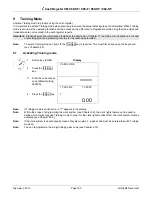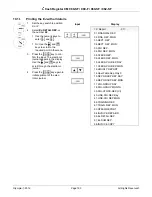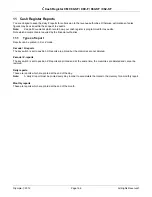
Cash Register CM 980-SF / 980-F / 960-SF / 962-SF
Olympia 2012
Page 152
All Rights Reserved!
8.4
Entering cooking messages
Cooking messages relate to additional information for the kitchen, e.g. how a steak should be prepared: rare, medium,
well-done etc. or whether a meal should be served with or without a side salad.
Cooking messages only appear on the order messages, not on the bills.
A maximum of 50 cooking messages can be available which must have been programmed accordingly beforehand (see
Chapter 6.29). Up to 30 cooking messages can be assigned to separate keys on the keyboard (see Chapters 4.3.2
and 6.33). A maximum of 4 cooking messages can be printed for each item.
8.4.1 Registering
preprogrammed cooking messages
Example:
Cooking message no. 22 must be registered for an item on the order message.
1. Set the key to REG.
Input
2. Register
the
PLUs.
3. Enter the number of the
cooking message.
22
4. Press
the
┣
Cooking Code
┫
key.
@
Note:
Instead of completing Steps 3 and 4, you can also print the relevant cooking message key when it has been
programmed on the keyboard beforehand (see Chapters 4.3.2 and 6.33).
8.4.2
Registering free cooking messages
Example:
The cooking message "spicy" must be printed in respect of a PLU on the order message.
1. Set the key to REG.
Input
2. Register
the
PLUs.
3. Pressing
the
┣
Cooking Code
┫
key.
@
4. Enter the required
cooking message
(max. 10 characters).
8x
1
5x
1
6x
4
6x
8
7x
3
5. Confirm the input again
by pressing the
┣
CASH
┫
key.
T
6. Conclude
programming
text input by pressing
the
┣
SUB-TOTAL
┫
key.
R
Note:
Instead of completing Steps 3 and 4, you can also press the relevant cooking message key if it has been
programmed on the keyboard beforehand (see Chapters 4.3.2 and 6.33).



